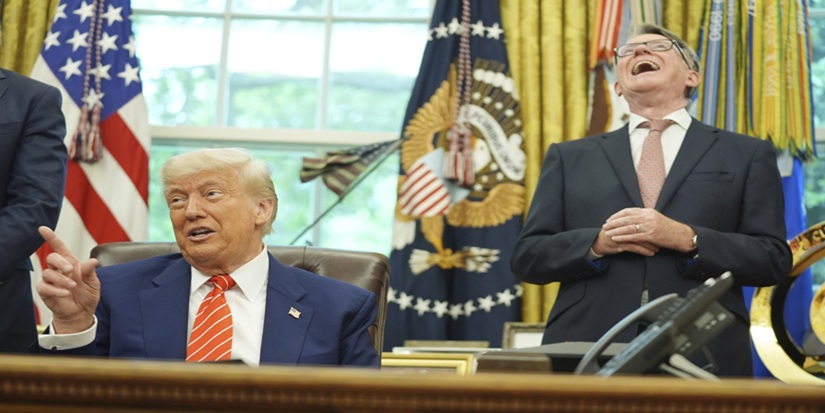You may have noticed some recent changes in US trade policy. They’re mostly in line with what President Trump described during his campaign. Yet a bunch of people were shocked he actually did it.
Wall Street calmed down a bit after the US and China agreed to temporarily reduce the astronomical tariff rates they had imposed on each other, pending further negotiations. Now we’re waiting to see what comes next.
No doubt there will be some kind of “agreement.” The bigger question: whether it will solve the problems that led us into this situation.
Count me skeptical, for two reasons.
Trade-wise, the US is in a box with no way out.
Constant Flux
The photo above is from the January 2020 signing of Trump’s “Phase 1” trade deal with China. It was the culmination of his first term trade war.
We don’t know how Phase 1 would have worked since COVID disrupted everything a few weeks later. I wasn’t optimistic. I wrote an article at the time called Seven Reasons Phase 1 Is a Terrible Trade Deal. Here are some of those reasons…
#1: The Ground Is Still Moving
Tariffs are manageable if businesses know what to expect. That’s not how Trump operates. He uses uncertainty as a negotiating tactic. He believes keeping the opposition confused gives him an advantage.
Unfortunately, it confuses innocent bystanders, too. If you are an import-dependent US company, you need to know your input costs with reasonable certainty—not just now, but a year from now.
They still don’t have such certainty, since everyone knows Phase 1 could easily fall apart or Trump could target other countries. So businesses remain reluctant to make capital investments and expand capacity. This reduces economic growth.
#3: The Battle Will Shift Elsewhere
Media reports call Phase 1 a “ceasefire” or “truce,” but the firing hasn’t ceased. It’s not a truce when the warring parties simply agree to shoot smaller bullets at each other.
Meanwhile, we have other trading partners, and a president who likes using his trade powers to accomplish other goals.
Every industry must still wonder when it will get dragged into someone else’s fight. The trade war isn’t over. It’s just relocating.
#4: Fantasy Farm Purchases Won’t Help US Farmers
Phase 1 commits China to buy more US farm products—this year $12.5 billion more than the $24 billion it bought in 2017. Then in 2021, Chinese purchases are supposed to be $19.5 billion over the 2017 baseline.
In other words, the totals will be $36.5 billion in 2020 and $43.5 billion in 2021—far more than ever seen before.
To meet those targets, US farm production will have to grow considerably, and/or we will have to sell goods to China that would have gone to other countries.
We won’t know for a long time if this deal actually helps US farmers. But lower sales in 2018–2019 definitely hurt them.
#7: Phase 1 Rewards Socialism
If you think socialism and economic central planning are bad ideas, you should hate Phase 1. It promotes both.
Consider those agricultural purchase commitments. Exactly how will the Chinese government keep that promise? Beijing will simply order companies to buy US products, whether it makes business sense or not. Phase 1 depends on exactly the kind of “state control” the US ostensibly wants China to abandon.
This deal is, as one analyst called it, “Communism with American characteristics.” It compromises core American principles for short-term financial and political gain.
(End quote)
Will a 2025 deal be any better? We’ll see. But there’s another problem.
Executive Orders
President Trump’s tariffs are all being done under executive authority. That means any future president could change them. In fact, nothing stops Trump himself from reneging on any deal he makes. Experience suggests he probably will, too.
Further, a number of pending lawsuits claim Trump’s tariffs are illegal or unconstitutional. This casts more doubt on his agreements.
There’s no reason for China or any other country to believe they have a permanent, enforceable deal with the US unless Congress approves it.
This is the same Congress that can’t even agree on a budget. Passing 100+ trade agreements while multiple special interests fight over every detail just isn’t in the cards.
This, in turn, means US businesses have no reason to make the long-range plans and investments needed to revive US manufacturing and generate the economic growth everyone wants.
Everyone talks about “certainty.” I think a better word is “stability.” Companies can handle a lot if they have stable trade, tax, and regulatory policies. When all those are constantly in flux, their best bet is to wait.
That kind of waiting cancels growth plans, reduces job opportunities, and stifles the animal spirits that make capitalism work.
Maybe we’ll find a way out of this box. But right now, I really don’t see one.
See you at the top,





